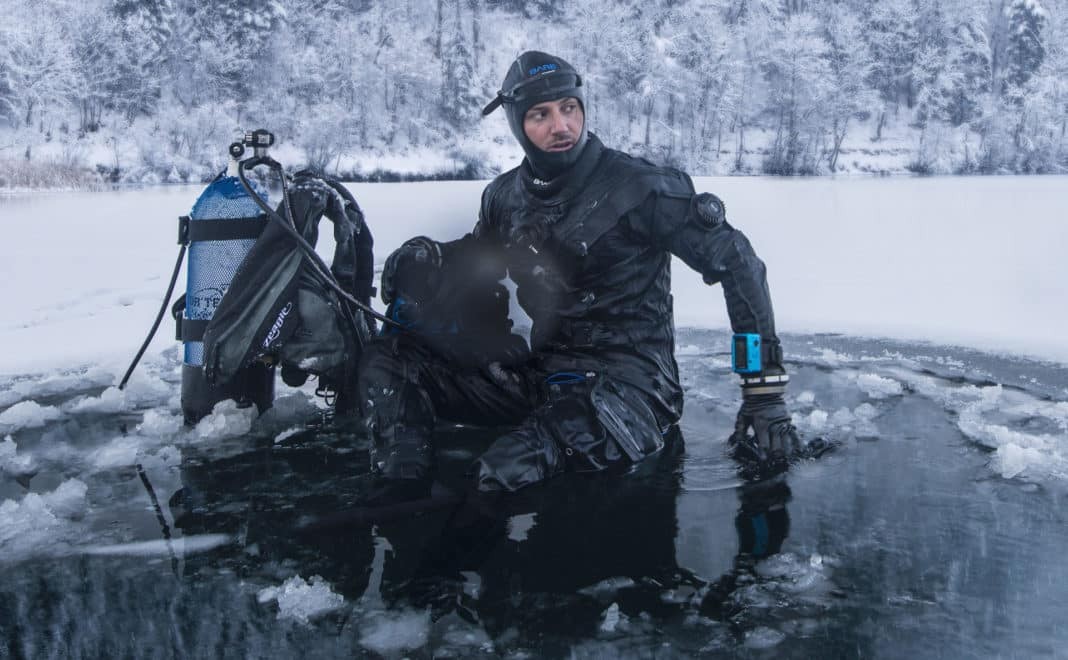Buying a new drysuit can be tough. Aside from the multitude of options and materials to consider, a drysuit can also be a hefty investment. With so many upgrades, add-ons and tweaks available, just getting started can be a little overwhelming.
So whether you’re just getting started—or are replacing your 20-year-old suit—it’s helpful to learn more about modern drysuit technology and how it aligns with your specific needs as a diver.
The first (and perhaps most important) decision is what type of material you want your suit to be. BARE drysuits are either trilaminate, bilaminate or neoprene, and each has its own net positives and performance highlights.
Materials
Trilaminates are three-layer fabrics with a waterproof butyl rubber membrane laminated between an outer layer and an inner layer. They are generally designed for a variety of uses and range from lightweight durability to extremely robust.
Bilaminates are made of two layers. A waterproof polyurethane coating on the outside provides a barrier, and the inner material is a textured nylon base fabric. BARE’s bilaminates are extremely durable, and in some cases, offer excellent chemical protection.
Neoprene is made in ‘buns’. They are cooked in an oven, then ‘sliced’ horizontally into the thickness required (6.5mm, 5.0mm, 3.0mm). The slices are sometimes compressed to offer more stable thermal and buoyancy characteristics and laminated on one or both sides, depending on the purpose.
If and when—by some ill happenstance or damage—your suit floods, neoprene will retain its insulating properties better than both bilaminate and trilaminate materials.
Seals
After choosing your suit’s material, it’s time to consider what type of seals you want.
There are three different types of seals: latex seals, silicone seals and neoprene seals—and the one you pick should largely be based on personal preference.
Neoprene seals are built into the suit and are typically bulky. On average, however, they provide better warmth (and last longer) than other seal types, making them popular with people who put a premium on heat retention and durability. For some, neoprene seals can cause a skin rash over sustained periods of use, so keep that in mind if you have sensitive skin.
Silicone seals are good because you can cut them to your desired size. If you cut a seal, just be careful and sure before you make a cut. Silicone works better in hot environments, but snaps in cold. Also, silicone seals are more susceptible to rips and tears, especially when putting on/taking off your suit.
Latex seals are pretty similar to silicone. You can cut them, but both tear easily and are replaceable. Latex seals cause reactions in certain divers, so check that before committing to a purchase. FYI: Latex can melt when exposed to ozone, or UV, so be sure to protect your latex seals from long-term sun exposure.
Neoprene seals aren’t replaceable and are attached to the suit, where silicone and latex are more modular, snap-on/snap-off type of designs.
Regarding the neck seal, folks tend to have different preferences. But it’s important to get this right because a lot of people feel constricted around their neck when wearing a drysuit—and starting with a solid foundation is key!
When considering wrist seals, we’re considering the same factors, but also the types of movements and stresses that go with that part of your body. A big bonus for silicone and latex seals: you can use dry gloves with them. With neoprene, you can insert cuffs into the seals like any other system.
Aside from core technologies and underlying design, it’s important when configuring and/or buying your suit that you make sure it fits well. When diving, you’ll want to make sure that the air stays balanced—not bunching in one region of the suit—so always remain cognizant of a suit’s potential air distribution.
If you’re a cold-water diver and wear a lot of bulky underlayers, be sure to try on your potential suit with the insulation layers you’ll be diving with in the field. It’s always better to check ahead of time and avoid unexpected fitting issues.
Likewise, it’s important to make sure your neck isn’t constricted and that you can breathe. It’s easy to put up with some discomfort for a few minutes when trying it on, so be honest with yourself, and imagine how it would feel diving over the long term, in a variety of conditions.
This is a sponsored post – for more information please see our disclosure policy.

